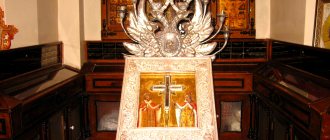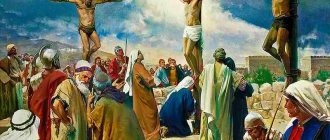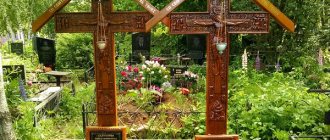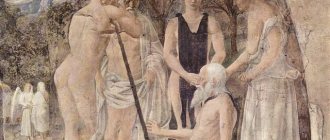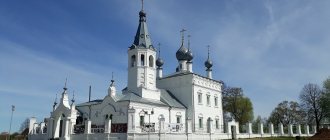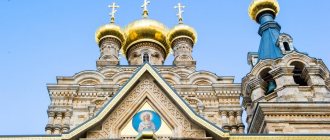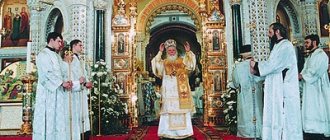Life-giving Cross of the Lord
|
Its exact copy appeared recently in the Samara temple.
In the Samara church in honor of St. Spyridon of Trimifuntsky, before Easter, a new shrine appeared - the Cross of the Lord, made according to the exact dimensions of the Life-giving Cross on which the Lord Jesus Christ was crucified. Entering the Sunday school room and seeing the Cross, you stop before it in amazement and involuntary awe: you can feel the Divine saving power of Christ Crucified in it. The vertical beam of the Cross almost rests on the high ceiling. It seems incredible that such a huge Cross could be carried by one person.
The Cross of the Lord is the main symbol of Christianity. This is the instrument of the Passion of Christ and the instrument of our cleansing from sins. According to the Venerable Nektarios, Elder of Optina, “the human heart will be able to escape from vanity, chaos, idleness, emptiness, and death only when it stands at the Crucifixion of Christ. Just as two thousand years ago, so today, in our days, the Cross of the Lord stands in the middle of the entire Universe, and it is impossible for anyone to get around it.”
But in our Orthodox churches, exact copies of the Holy Cross are rarely found. John Mokhov , dean of the Central Deanery of the city of Samara, tells how such a copy of the Cross of Christ appeared in the Church of St. Spyridon :
“At the very beginning of Lent, we gathered as parish activists, and I proposed to discuss what kind of exhibition we should make for Easter. The idea was for our parishioners to experience the Gospel events more deeply - the events of Holy Week and Easter.
And we decided to make the Cross of the Lord, which would coincide one in one with the Life-giving Cross on which the Savior was crucified. We started by finding out the exact dimensions of the Cross. This turned out to be difficult: they are not indicated in the sources. But we managed to find a description of the Kiysk Cross, which was made in the 17th century in Jerusalem based on the model of the Cross of the Lord for the Russian Patriarch Nikon. While still a hieromonk, Nikon almost drowned on a boat in a storm and was saved by landing on the deserted island of Kiy in the Onega Bay of the White Sea. He made a vow and built the Kiysky Cross Monastery on this site, for which he ordered a Cross in Jerusalem “in the measure and likeness” of the Cross of the Lord. A particle of the Life-Giving Cross, many particles of the relics of saints and stones from the sites of biblical events were placed in it. Now this Cross is in front of the altar in the Moscow Church of St. Sergius of Radonezh in Krapivniki.
Having found out the dimensions of the Cross, we turned to various carpentry and carpentry workshops, but everywhere we were told that such a cross cannot be made quickly, we need to think, weigh everything. When there were only ten days left before Easter, I said: “That’s it, let’s do the cross ourselves!” We found wood that met the standards - pine. Although the central beam of the Holy Cross was three-component: cedar, cypress and pine. The tree from which the Cross of the Lord was made, according to legend, grew from three staves. When the Most Holy Trinity appeared to Abraham in the form of three Angels, before leaving for Sodom to punish the city for wickedness, they left Abraham three staves. These staves miraculously sprouted into a triune tree. It became a special, sacred tree. When King Solomon built the Temple of Jerusalem, one column was missing to support the roof of the temple. They cut down the tree and made a column out of it, but it didn’t fit anywhere. After this, the timber was buried in the ground. He was right in the Pool of Siloam, which was famous for its healings because of this. When Pontius Pilate handed over the Lord to crucifixion, the tree in the source surfaced. The Jews decided to use it to make a vertical supporting pillar for the Cross of the Savior.
—What are the dimensions of the Cross of the Lord?
— The height of the vertical beam is three meters nine and a half centimeters, the transverse beam is one meter ninety-five centimeters long. The vertical beam of the Savior's cross weighed about one hundred and twenty kilograms! Our beam weighs seventy-four kilograms. There is no definitive indication that the top bar was nailed down, but sources say it was most likely tied down, so we tied it down with rope. The tree was wasted, because the sacred tree lay in the water for many centuries and turned black.
“The size of not only the Cross, but also the instruments of the Lord’s Crucifixion on display—nails and spears—is striking.
“We decided that they should also be on display. The Roman ceremonial spear, or melee spear, had such a wide tip. This is a murder weapon, such a spear can easily pierce a person through. Nails are widely described in the literature. One of them, donated to the Russian Orthodox Church, is located in the Cathedral of Christ the Savior. Recently, it was shown to all believers from the pulpit of the Temple by His Holiness Patriarch Kirill of Moscow and All Rus'. The nail is fourteen and a half centimeters long and weighs seventy-five grams. They are really very big. While studying New Testament archaeological sources at one time, I learned that when people were found buried after Roman execution on the cross, the nails could not be pulled out of their hands. They were torn from the cross along with the nails and buried like that. The Romans executed in this cruel way. The man experienced terrible agony when nailed to a tree, and then hung alive on these nails for a long time. Against this background, the execution of a Roman citizen by beheading looks comparatively more humane.
Sometimes the Savior is depicted with pierced palms. But the streaks of blood on the Shroud of Turin are at the wrists. The palms would not have supported the weight of the person, he would have simply fallen. When the hand breaks through the wrist, the tendons are torn and an instant contraction of the phalanx of the thumb occurs, it immediately “dies” - that’s why only four fingers on each hand are visible on the shroud, the big ones tucked inward.
Looking at all this, one can feel that the Calvary sacrifice that the Lord Jesus Christ made for us was truly a martyr’s sacrifice of love that only God could make for the human race.
In this exhibition, the historical relics are the Crown of Thorns and a small cross, which were brought by our pilgrims from Jerusalem. Cross of the late 19th century, three-part, similar to the Cross of the Lord. The crown is made from a thorn bush growing within Jerusalem. Such a thorn was wrapped around the Savior’s head. The crown is very different from those that are brought from Jerusalem today; they are more similar to the rose hips we are familiar with. And here were deadly needles several centimeters long, which pierced the head and could pierce not only the skin, but also the bone. But this crown of thorns is not entirely accurate: the real one was woven in the form of a hat and covered the entire head.
“It’s touching to see how a little girl of about five ran here and kissed the glass under which the nails were displayed.”
“On Good Friday, the children themselves wanted to and with reverence carried the image of the Savior on the Shroud of Turin, nails, a spear, and a crown of thorns during the procession. One child was asked what kind of nails he was carrying. He replied: “These nails were used to nail the Lord Jesus Christ to the cross.” When he grows up, he will have spiritual immunity to any sects. , His Calvary sacrifice. The gospel truth is perceived by them naturally, correctly and forever.
We consecrated the Cross of the Lord and carried it around the temple on Good Friday. The three men who carried him later said that it was very difficult not only physically, but also mentally.
The cross leads to true worship of God. We are negotiating with the Sretensky Monastery in Moscow: they promised to make for us a copy of theirs, again, a copy of the Shroud of Turin. We want to hold a religious procession similar to the one that goes on Good Friday in Jerusalem with the Cross, and then with the Shroud from the judgment seat of Pontius Pilate to Golgotha.
Lyudmila Belkina
From the editor. On these same days - from April 20 to 27 - in the Samara church in honor of St. Spyridon of Trimifuntsky there was an ark with a particle of the relics of the blessed Matrona of Moscow and other saints, and many believers came to this temple. The line to the shrines ended far beyond the temple gates...
Photo by Ekaterina Zhevak.
God and our suffering
God does not rejoice in the suffering of mankind. The Lord came into this world to take man away from suffering. They are not sent by God, but are the result of man’s falling away from Him, the result of the distortion of the world in which humanity exists after the Fall. Suffering is alien to the nature of God as such.
However, without any doubt, suffering occurs in human life. The only question is how much a person can accept them and bear them with dignity, with prayer and meet Christ Himself in them. It is important to see the presence of God in your suffering, because He, having taken upon Himself the suffering of people, is also present in each of our personal suffering. Where a person suffers, God is next to him.
If a person has enough courage, faith, love, trust in God, then it is then in his suffering that person meets the crucified Christ. And then a person in them can become like God. In this sense, we can call human suffering – bearing the cross.
But not every suffering can be the bearing of a cross. In trials, a person can reject God, blaspheme Him, rebel against God, hate both himself and others, fall into despair and lose faith. In this case, it cannot be called carrying the cross, because the cross saves a person, and does not destroy.
What does the Cross symbolize?
The Honest Cross of the Lord is the unifying force of humanity. The two transverse bars of the Cross symbolize the union of people with God (vertical bar) and the union of people with each other (cross bar). Of course, the unification of people necessarily occurs through their relationship with God. The crossbar also symbolizes the two arms of the Crucified Savior, which are open to embrace and embrace all humanity.
The Holy Cross is a formidable weapon against dark forces. Before the crucifixion of Christ, the cross was used as an instrument of evil for destruction and death. After Christ volunteered to be crucified, the cross became a weapon against those who used it.
Believers now proudly wear the cross as a precious and effective bulwark against evil, but also as an acknowledgment of their faith in the great atoning sacrifice of Christ. It is worth noting the obvious disgust and even hatred of the Cross of Christ of many heretical Christian groups. In general, the Protestant world does not honor the Cross. It is known that Protestants do not cross themselves and use the cross only as an element.
The state of despair and bliss that the presence and sight of the Holy Cross evokes in our soul forces us to courageously and patiently endure life’s difficulties, that is, to bear our personal cross:
“Then Jesus said to His disciples, “If anyone wants to come after Me, let him deny himself, and take up his cross, and follow Me.” (Matt. 16:24)
We hope for the coming Resurrection, literally and figuratively. This unshakable faith gives us strength and makes us look at life with optimism.
Celebration or tragedy?
All the events we experience in the Church are filled with a variety of feelings and experiences; here joy and sorrow, fear and hope for the resurrection can be present. Like every meeting with God, for us it is a judgment, and a joy of meeting, and a resurrection, and a terrible Second Coming.
In general, every evangelical event reflected in Orthodox worship is a meeting with reality. But reality cannot be unambiguous, since we are still living in it, we are still implementing it. And, on the one hand, meeting reality for a person is always a great happiness, because he meets the truth. At the same time, this truth is not always sweet.
And now, we will stand in the church in front of the Cross and understand that our bitter truth of meeting the cross is such that it is both suffering and light, and the experience of distance from God, and the joy of the fact that He still has us immensely and infinitely loves.
“We worship your cross, Lord”
Photo from the website monastery.ru
At the festive all-night vigil for the Exaltation of the Cross (September 26), while singing “Holy God...”, the priesthood carries the Cross into the middle of the church.
When the Cross is taken from the altar to the center of the temple, the priesthood together with the believers worship the Cross, making three prostrations to the ground. At this time, the whole Church sings the troparion to the Cross:
“We worship Your Cross, Master, and we glorify Your holy Resurrection” (three times).
The same troparion is also sung at the Liturgy of the holiday instead of “Holy God...”.
Attention: anointing with oil at this service occurs only after the removal of the Cross, almost at the very end of the service. After placing the Cross on the lectern, believers approach the Cross with a kiss, and the priest anoints them with holy oil. The cross is on the lectern for six days, until the celebration of the Feast.
Location. Accessibility for pilgrims[edit]
This table presents the most famous places in the Christian world for storing particles of the Life-Giving Cross.
| A country | Temple (Monastery) |
| Austria | Heiligenkreuz |
| Armenia | Echmiadzin |
| Belgium | Onthaalkerk Church in Bruges |
| Germany | Church of St. Cecilia, Dusseldorf |
| Greece | Athos monasteries: Iveron, Dionysiat, Kotlumush, Xiropotamus (part pierced with a nail), Philothea, Simonopetra, St. Paul, Stavronikita and Esphigmen - single particles; Great Lavra, Vatopedi, Hilandar, Pantokrator, Zograf and Caracal - several particles |
| Georgia | Svetitskhoveli Cathedral (particle). According to legend, part of the Cross, one of the nails, as well as the foot of the Cross were donated to Georgia by Emperor Constantine. The foot was lost under the Georgian king George XII |
| Israel | Church of the Holy Sepulcher - the largest known part of the Cross |
| Spain | Monastery of Santo Toribio de Liebana, Cantabria |
| Italy | Rome: St. Peter's Basilica, Basilica of Santa Croce in Gerusalemme, Pisa Cathedral, Santa Maria del Fiore in Florence |
| Cyprus | The Stavrovouni Monastery is a piece, according to legend, left by St. Helena at the founding of the monastery. The Monastery of the Holy Cross in the village of Omodos is a piece of the Cross and the bonds (ropes) that tied the hands of Jesus Christ on the way to the crucifixion. |
| Latvia | Cathedral of the Old Believer Grebenshchikov community in Riga. |
| Russia | Alexander-Svirsky Monastery, Annunciation Monastery (Nizhny Novgorod), Holy Cross Convent (Nizhny Novgorod), Epiphany Cathedral in Elokhov (Moscow), Resurrection-Fedorovsky Monastery, Holy Cross Monastery (Ekaterinburg), Pokrovsky Alexander Nevsky Monastery, Trinity Cathedral of the Trinity -Sergius Lavra, Church of Anastasia the Pattern Maker (Pskov), Holy Cross Kyltovo Convent, Temple of St. Sergius of Radonezh in Krapivniki. |
| Ukraine | Church of the Exaltation of the Cross (Vinnitsa), Cathedral of the Exaltation of the Cross (Uzhgorod), Assumption Cathedral (Mukachevo), Holy Dormition Pochaev Lavra, Church of the Exaltation of the Cross of the Kiev-Pechersk Lavra |
| France | Notre Dame Cathedral, Abbey of the Holy Cross, Poitiers (particle, from 568), Church of St. Claudius, Paris (particle brought from Jerusalem on July 28, 1109) |
| Montenegro | Cetinje is a particle that previously belonged to the Order of Malta, then located in Russia (Winter Palace and Gatchina, until 1917) |



